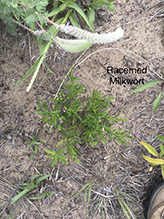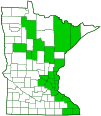racemed milkwort
(Polygala polygama)
Conservation • Wetland • Description • Habitat • Ecology • Use • Distribution • Taxonomy
Description |
||
Racemed milkwort is a common native wildflower. It occurs in the eastern United States from Maine to Florida west to Minnesota and Texas, and in Canada in southern Quebec and Ontario. In Minnesota it is most common in the eastern third of the state. It is found in upland open woodlands and woodland openings, in savannas and abandoned fields, and on sand dunes and roadsides. It grows under full or partial sun in moderately moist to dry areas on sandy soil. Racemed milkwort is a 4″ to 10″ (10 to 25 cm) tall, erect, biennial forb that rises on a compact cluster of multiple stems from a deep, slender taproot. The plant form is variable. The stems may be erect, curve up from the base (ascending), or lay on the ground with only the tip ascending (decumbent). They are leafy, green, hairless and sharply angled but not square. They are unbranched at flowering time then sparingly branched in fruit. The leaves are alternate and crowded on the stems. Lowest leaves are ⅜″ (1 cm) long, spoon-shaped to egg-shaped, and widest beyond the middle. Stem leaves are ⅜″ to 1¼″ (1 to 3 cm) long and 1⁄16″ to ¼″ (2 to 7 mm) wide. They are stalkless and ascending to widely spreading. The leaf blades are narrow and inversely egg-shaped or inversely oblong lance-shaped. They have a single prominent vein and may be pointed, blunt, or rounded at the tip. The upper and lower surfaces are hairless. The margins are untoothed. Two types of flowers are produced: open, cross-pollinated (chasmogamous) flowers; and closed, self-fertilizing (cleistogamous) flowers. The inflorescence is a loose, open, narrow, spike-like, ¾″ to 4″ (2 to 10 cm) long, unbranched cluster (raceme) at the end of each stem. Each flower is on a 1⁄16″to ⅛″ (1.5 to 3.5 mm) long stalk (pedicel). There are sometimes a few cleistogamous flowers at the bottom of this raceme. There are also a few white cleistogamous flowers that rise from an underground raceme. Individual flowers are ⅜″ to ¼″ long. There are 5 outer floral leaves (sepals), 3 petals, 8 stamens, and 1 style. The upper sepal and lower two sepals are small and green or whitish-green. The lateral two sepals are petal-like and are referred to as wings. The wings are rose-purple to white, ⅛″ to ¼″ (4 to 6 mm) long, and widest near the tip. The petals are rose-purple to white and are fused into a U-shaped tube, open on one side, around the stamens and style, and separated at the tip into three lobes. The lateral two lobes, structurally the upper lobes, are similar. The central lobe, structurally the lower lobe and referred to as the keel, is boat-shaped and fringed. The stamens have yellow anthers. The stalks of the stamens (filaments) are fused into a tube which is fused to the keel. The style has 2 lobes near the tip. The upper lobe has a cap-like stigma. The lower lobe is sterile and has a fringe of hairs. The fruit is a pale, 1⁄16″to ⅛″ (3 to 4 mm) long, egg-shaped capsule. |
||
Height |
||
4″ to 10″ (10 to 25 cm) |
||
Flower Color |
||
Rose-purple to white. |
||
Similar Species |
||
Habitat |
||
Moderately moist to dry. Upland open woodlands, woodland openings, savannas, abandoned fields, sand dunes, and roadsides. Full or partial sun. Sandy soil. |
||
Ecology |
||
Flowering |
||
June to August |
||
Pests and Diseases |
||
|
||
Use |
||
|
||
Distribution |
||||
|
Sources |
|||
| 12/6/2021 | ||||
Nativity |
||||
Native |
||||
Occurrence |
||||
|
||||
Taxonomy |
|||
| Kingdom | Plantae (green algae and land plants) | ||
| Subkingdom | Viridiplantae (green plants) | ||
| Infrakingdom | Streptophyta (land plants and green algae) | ||
| Superdivision | Embryophyta (land plants) | ||
| Division | Tracheophyta (vascular plants) | ||
| Subdivision | Spermatophytina (seed plants) | ||
| Class | Magnoliopsida (flowering plants) | ||
| Superorder | Rosanae | ||
Order |
Fabales (legumes, milkworts, and allies) | ||
Family |
Polygalaceae (milkwort) | ||
| Tribe | Polygaleae | ||
Genus |
Polygala (milkwort) | ||
Subordinate Taxa |
|||
Some authorities, including Gleason & Cronquist, recognize two or three varieties. Of these, only Polygala polygama var. obtusata occurs in Minnesota. It is the northern variety and has a slightly denser raceme. The varieties are not widely accepted and are treated by most authorities as synonyms |
|||
purple milkwort (Polygala polygama var. obtusata) racemed milkwort (Polygala polygama var. polygama) racemed milkwort (Polygala polygama var. ramulosa) |
|||
Synonyms |
|||
Anthalogea polygama Polygala aboriginum Polygala polygama var. obtusata Polygala polygama var. polygama Polygala polygama var. ramulosa |
|||
Common Names |
|||
bitter milkwort purple milkwort racemed milkwort |
|||
Glossary
Ascending
Growing upward at an angle or curving upward from the base.
Cleistogamous
Automatically self-pollinating. Refers to bud-like flowers that do not open but automatically self-pollinate, or to plants with such flowers.
Decumbent
Reclining on the ground but with the tip ascending.
Filament
On plants: The thread-like stalk of a stamen which supports the anther. On Lepidoptera: One of a pair of long, thin, fleshy extensions extending from the thorax, and sometimes also from the abdomen, of a caterpillar.
Pedicel
On plants: the stalk of a single flower in a cluster of flowers. On insects: the second segment of the antennae. On Hymenoptera and Araneae: the narrow stalk connecting the thorax to the abdomen: the preferred term is petiole.
Raceme
An unbranched, elongated inflorescence with stalked flowers. The flowers mature from the bottom up.
Sepal
An outer floral leaf, usually green but sometimes colored, at the base of a flower.
Visitor Photos |
|||||
Share your photo of this plant. |
|||||
| This button not working for you? Simply email us at info@MinnesotaSeasons.com. Attach one or more photos and, if you like, a caption. |
|||||
Nancy Falkum |
|||||
 |
|||||
MinnesotaSeasons.com Photos |
|||||
|
|||||

Visitor Videos |
|||
Share your video of this plant. |
|||
| This button not working for you? Simply email us at info@MinnesotaSeasons.com. Attach a video, a YouTube link, or a cloud storage link. |
|||
Other Videos |
|||

Created: 12/6/2021
Last Updated:




